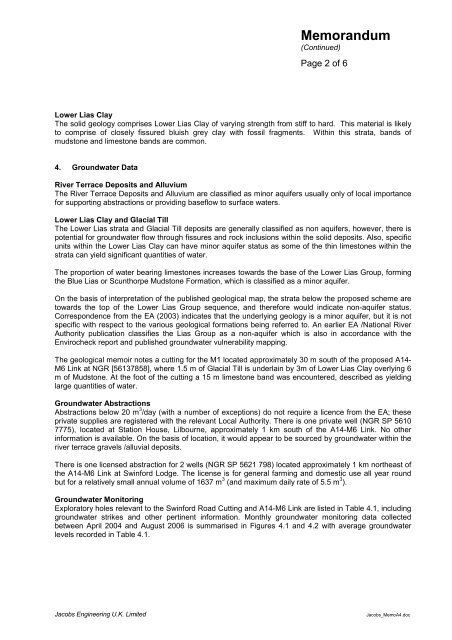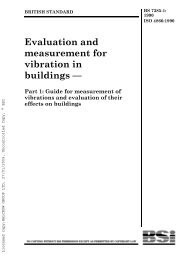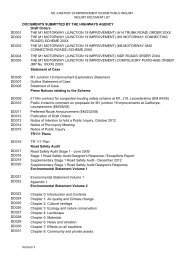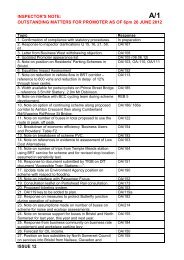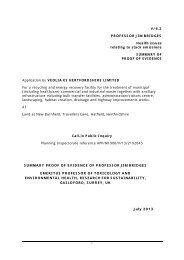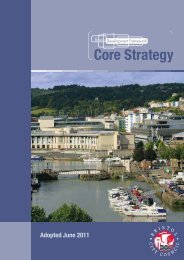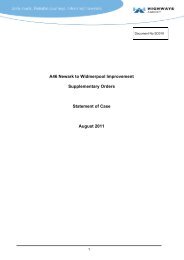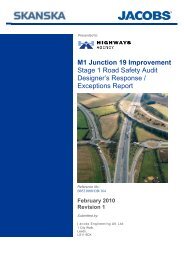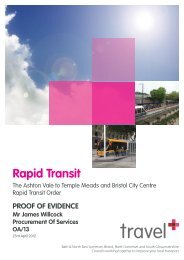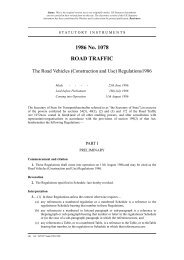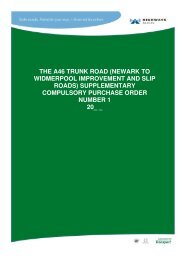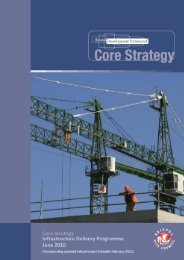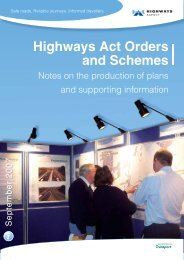Chapter 9: Road drainage and the water environment
Chapter 9: Road drainage and the water environment
Chapter 9: Road drainage and the water environment
Create successful ePaper yourself
Turn your PDF publications into a flip-book with our unique Google optimized e-Paper software.
Memor<strong>and</strong>um<br />
(Continued)<br />
Page 2 of 6<br />
Lower Lias Clay<br />
The solid geology comprises Lower Lias Clay of varying strength from stiff to hard. This material is likely<br />
to comprise of closely fissured bluish grey clay with fossil fragments. Within this strata, b<strong>and</strong>s of<br />
mudstone <strong>and</strong> limestone b<strong>and</strong>s are common.<br />
4. Ground<strong>water</strong> Data<br />
River Terrace Deposits <strong>and</strong> Alluvium<br />
The River Terrace Deposits <strong>and</strong> Alluvium are classified as minor aquifers usually only of local importance<br />
for supporting abstractions or providing baseflow to surface <strong>water</strong>s.<br />
Lower Lias Clay <strong>and</strong> Glacial Till<br />
The Lower Lias strata <strong>and</strong> Glacial Till deposits are generally classified as non aquifers, however, <strong>the</strong>re is<br />
potential for ground<strong>water</strong> flow through fissures <strong>and</strong> rock inclusions within <strong>the</strong> solid deposits. Also, specific<br />
units within <strong>the</strong> Lower Lias Clay can have minor aquifer status as some of <strong>the</strong> thin limestones within <strong>the</strong><br />
strata can yield significant quantities of <strong>water</strong>.<br />
The proportion of <strong>water</strong> bearing limestones increases towards <strong>the</strong> base of <strong>the</strong> Lower Lias Group, forming<br />
<strong>the</strong> Blue Lias or Scunthorpe Mudstone Formation, which is classified as a minor aquifer.<br />
On <strong>the</strong> basis of interpretation of <strong>the</strong> published geological map, <strong>the</strong> strata below <strong>the</strong> proposed scheme are<br />
towards <strong>the</strong> top of <strong>the</strong> Lower Lias Group sequence, <strong>and</strong> <strong>the</strong>refore would indicate non-aquifer status.<br />
Correspondence from <strong>the</strong> EA (2003) indicates that <strong>the</strong> underlying geology is a minor aquifer, but it is not<br />
specific with respect to <strong>the</strong> various geological formations being referred to. An earlier EA /National River<br />
Authority publication classifies <strong>the</strong> Lias Group as a non-aquifer which is also in accordance with <strong>the</strong><br />
Envirocheck report <strong>and</strong> published ground<strong>water</strong> vulnerability mapping.<br />
The geological memoir notes a cutting for <strong>the</strong> M1 located approximately 30 m south of <strong>the</strong> proposed A14-<br />
M6 Link at NGR [56137858], where 1.5 m of Glacial Till is underlain by 3m of Lower Lias Clay overlying 6<br />
m of Mudstone. At <strong>the</strong> foot of <strong>the</strong> cutting a 15 m limestone b<strong>and</strong> was encountered, described as yielding<br />
large quantities of <strong>water</strong>.<br />
Ground<strong>water</strong> Abstractions<br />
Abstractions below 20 m 3 /day (with a number of exceptions) do not require a licence from <strong>the</strong> EA; <strong>the</strong>se<br />
private supplies are registered with <strong>the</strong> relevant Local Authority. There is one private well (NGR SP 5610<br />
7775), located at Station House, Lilbourne, approximately 1 km south of <strong>the</strong> A14-M6 Link. No o<strong>the</strong>r<br />
information is available. On <strong>the</strong> basis of location, it would appear to be sourced by ground<strong>water</strong> within <strong>the</strong><br />
river terrace gravels /alluvial deposits.<br />
There is one licensed abstraction for 2 wells (NGR SP 5621 798) located approximately 1 km nor<strong>the</strong>ast of<br />
<strong>the</strong> A14-M6 Link at Swinford Lodge. The license is for general farming <strong>and</strong> domestic use all year round<br />
but for a relatively small annual volume of 1637 m 3 (<strong>and</strong> maximum daily rate of 5.5 m 3 ).<br />
Ground<strong>water</strong> Monitoring<br />
Exploratory holes relevant to <strong>the</strong> Swinford <strong>Road</strong> Cutting <strong>and</strong> A14-M6 Link are listed in Table 4.1, including<br />
ground<strong>water</strong> strikes <strong>and</strong> o<strong>the</strong>r pertinent information. Monthly ground<strong>water</strong> monitoring data collected<br />
between April 2004 <strong>and</strong> August 2006 is summarised in Figures 4.1 <strong>and</strong> 4.2 with average ground<strong>water</strong><br />
levels recorded in Table 4.1.<br />
Jacobs Engineering U.K. Limited<br />
Jacobs_MemoA4.doc


